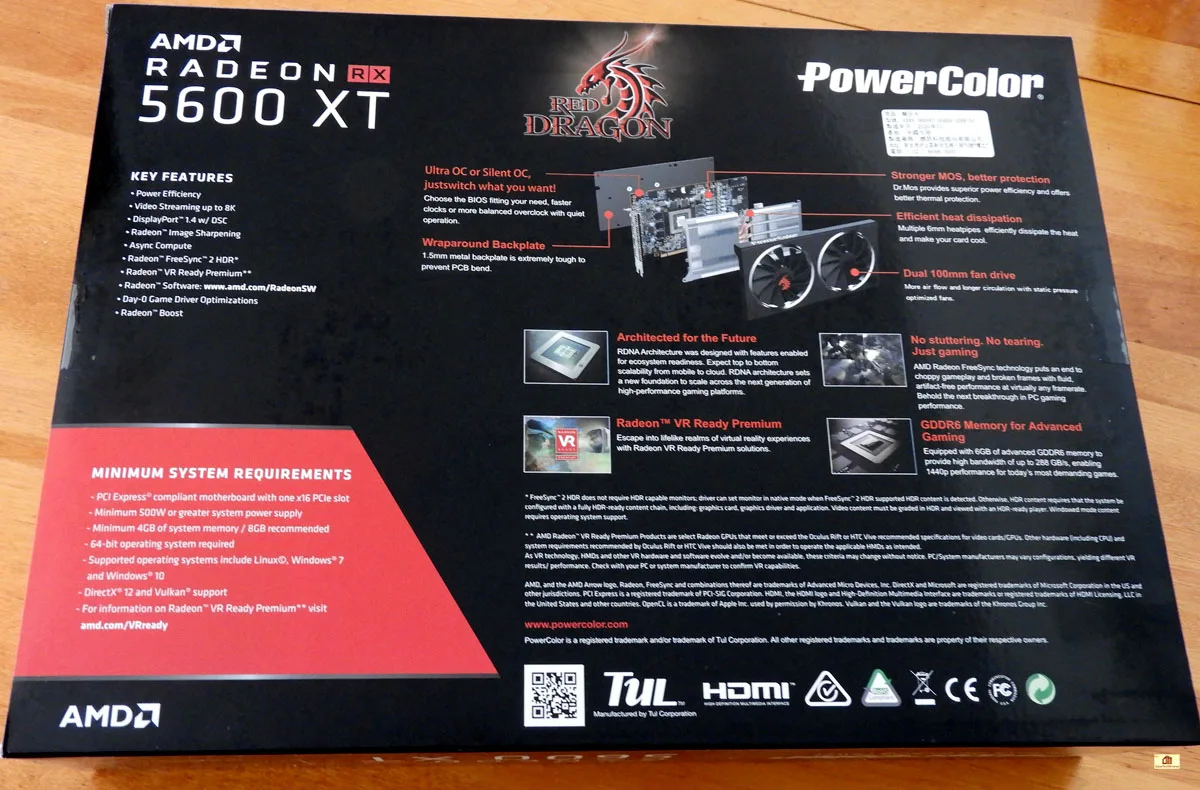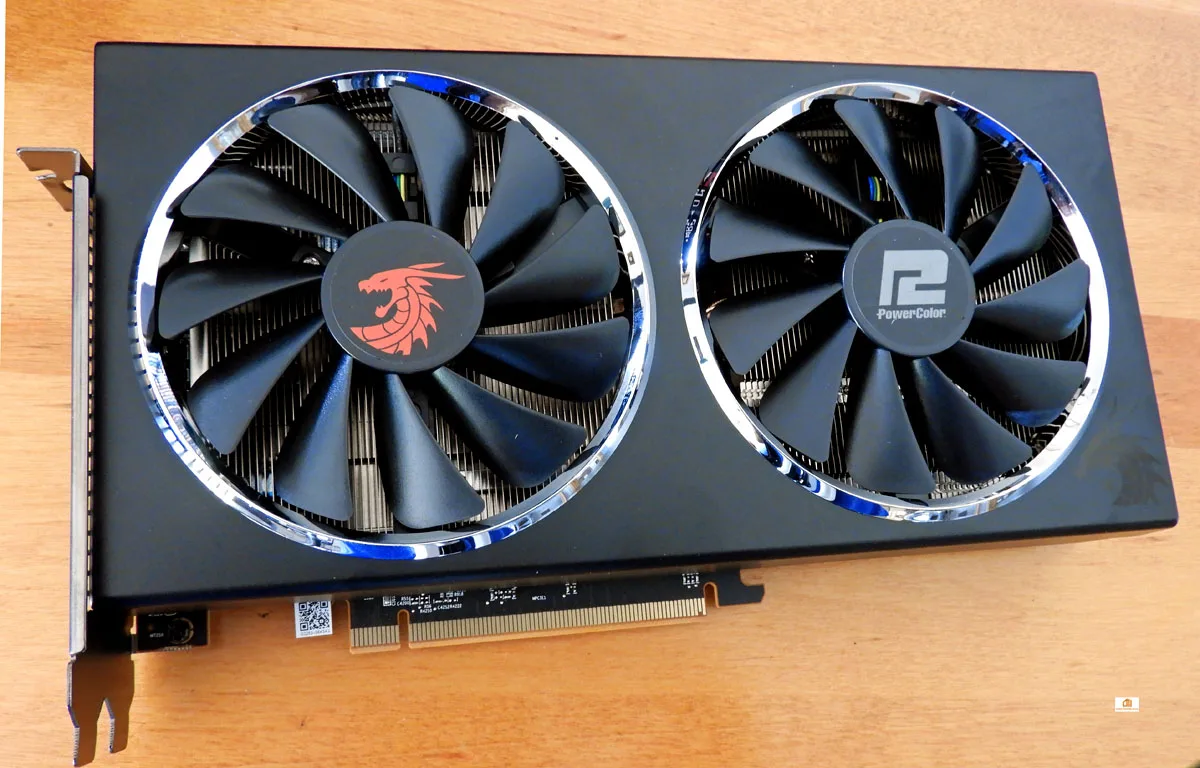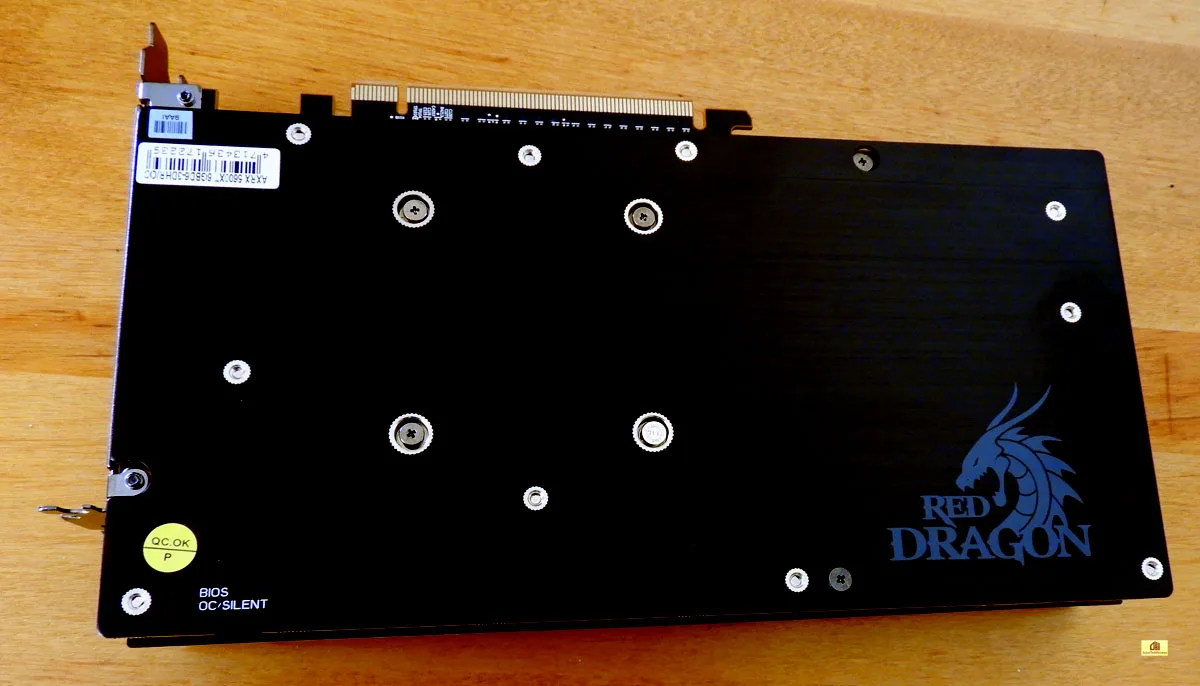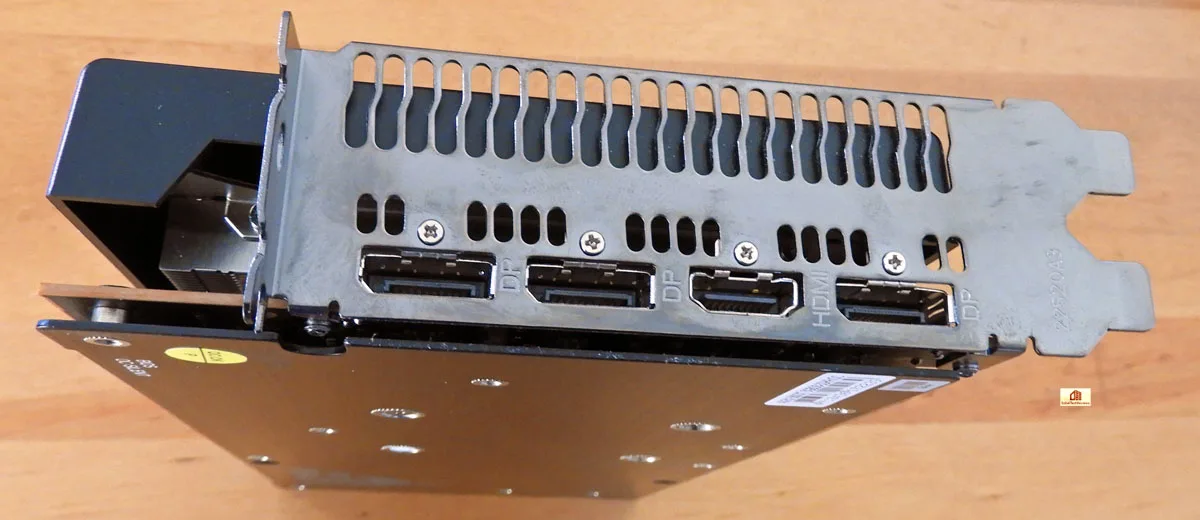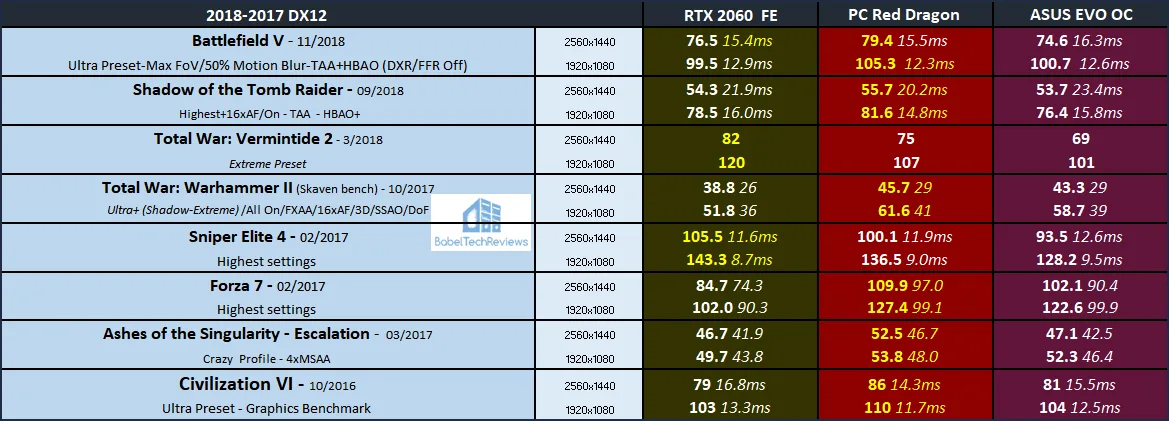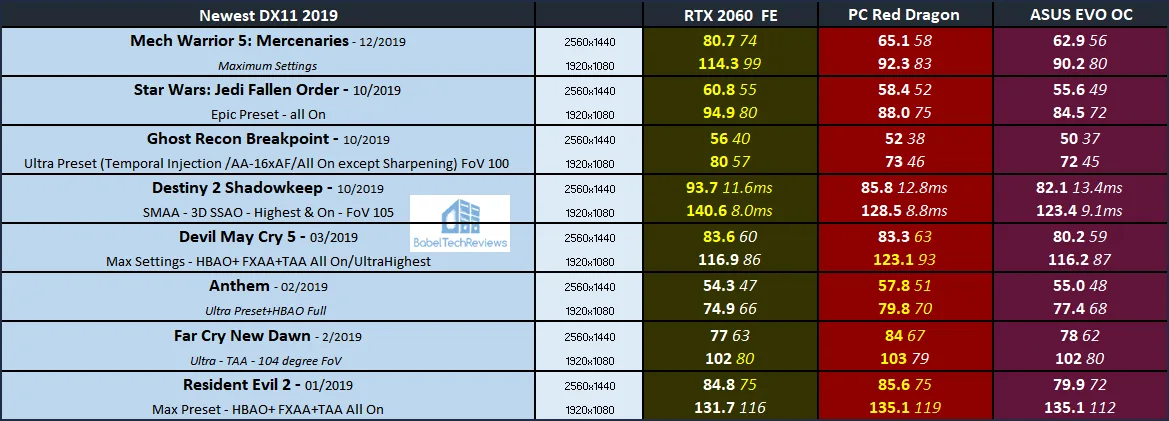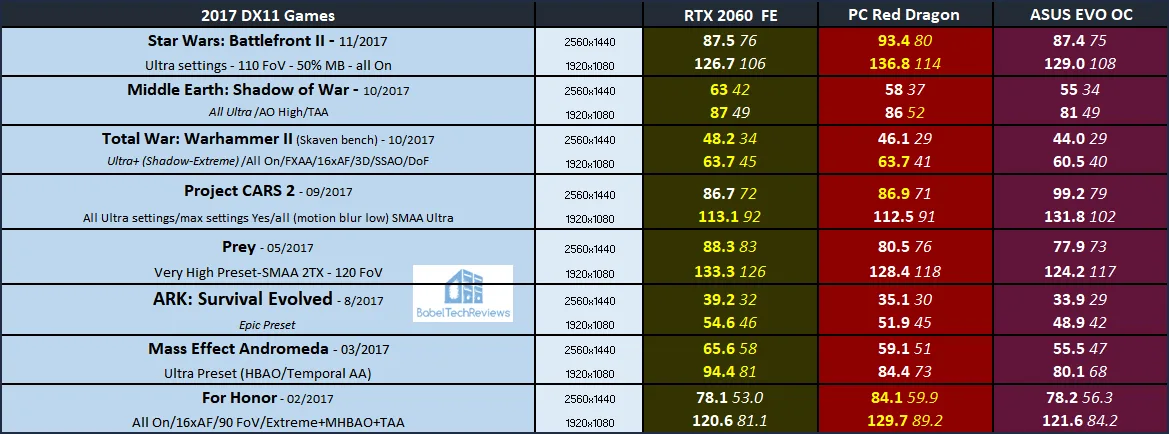The Red Dragon RX 5600 XT Benchmarked with 50 games vs. the RTX 2060 Founders Edition & vs. the ASUS X3 RX 5600 XT EVO OC
BTR received and benchmarked a Red Dragon RX 5600 XT 6GB ($289.99 MSRP) review sample from PowerColor versus the ASUS RX 5600 XT EVO OC 6GB ($309.99), and versus the RTX 2060 6GB Founders Edition ($299.99). Although these cards are designed for Ultra 1080P, 50 game benchmarks were also run at 2560×1440 to stress them beyond their limits.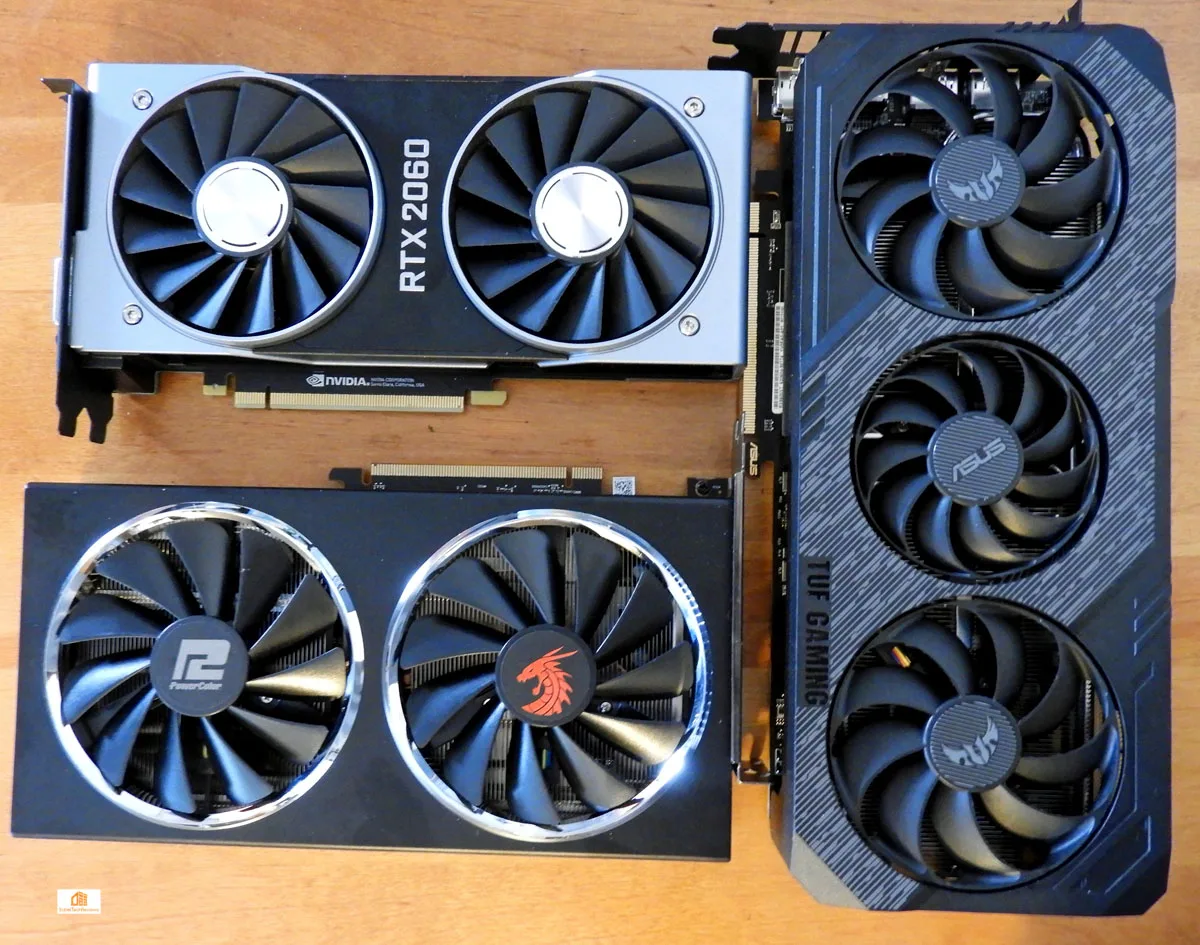
We posted our Tuff Gaming X3 ASUS RX 5600 XT EVOC OC 6GB review in January where it solidly beat the GTX 1660 Ti and the Super, and nothing has changed since then. The new vBIOS updated the memory from 12Gbps to 14Gbps, and every Red Dragon RX 5600 XT for sale already comes with the faster 14GBps memory. Although its MSRP is $289, Amazon and Newegg are each selling the Red Dragon RX 5600 XT for $299. Newegg has the better deal since they include a game bundle with RE3, Monster Hunter World, and 3-month XBox PC game pass. The GeForce competitor to the RX 5600 XTs ($279-$309) are the entry level RTX 2060 ($299) video cards.
The PowerColor Red Dragon RX 5600 XT 8GB
Although there is no AMD reference design, the Red Dragon RX 5600 XT 6GB shares the same specifications including the maximum Boost clock, but its game/Boost clock is set higher at 1560MHz/1620MHz which is also 10MHz faster than the ASUS RX 5600 XT EVO OC.
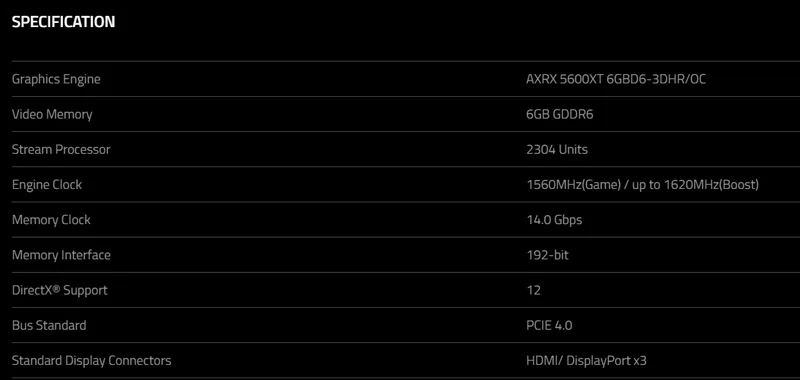
The Red Dragon specs look great and it should be a good match up versus the RTX 2060 Founders Edition, and versus the ASUS RX 5600 XT EVO OC, a bigger and a more expensive card.
Unboxing the Red Dragon RX 5600 XT 8GB
The Red Dragon RX 5600 XT 6GB comes in an medium box that advertise its features. The Red Dragon is an 6GB RX 5600 XT built on 7nm using AMD’s latest RDNA architecture and it features 4.0 PCIe support, Fidelity FX and FreeSync 2. “Memory clock at 14Gbps” makes it clear that it already uses the fastest memory.
The features and the minimum system requirements including the need for a 500W power supply are detailed on the back of the box. VR readiness, power efficiency, up to 8K video streaming, image sharpening, FreeSync 2 HDR, and other Radeon key features are listed.
Mute fan technology means the dual axial fans will come to a dead stop below 60℃ under a light gaming load providing silent gaming while reducing power consumption. PowerColor stresses that lower temperatures mean better performance. The cooling fan is equipped with two-ball bearings which increases longevity.
Opening the box we see a well-packed card and a quick start guide.
The Red Dragon RX 5600 XT 6GB is a handsome basic black non-RGB card with a dragon logo on the fan as well as one on the back. One 8-pin PCIe connector is required.
Turning it over, we see the Red Dragon logo on a solid metal 1.5mm backplate that protects the PCB against flexing and prevents damaging the traces.
There is a dual-BIOS switch that either automatically overclocks or downclocks slightly depending on user noise/performance preferences. We used the OC BIOS for maximum performance, and the card remained very quiet even under load.
Looking at the Red Dragon RX 5600 XT 6GB from one edge we see the large heatsinks with many dense fins that extend for much of the length of the PCB with the heatpipes connecting the heatsinks. 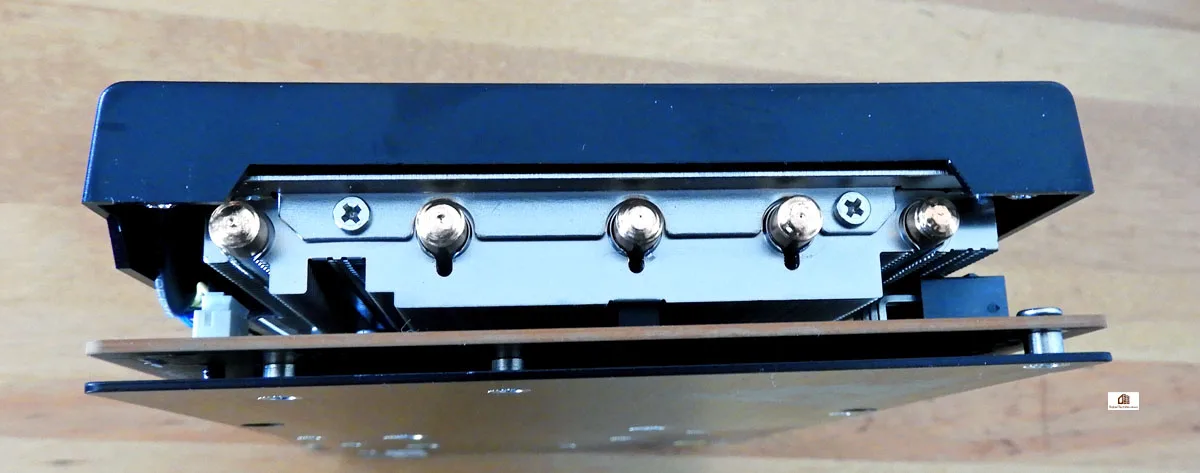
On one end, the connectors consist of three DisplayPorts and a HDMI connector. We like this setup better for SteamVR platforms than those with a DVI connector.
The Red Dragon RX 5600 XT 6GB looks good from any angle.
Before we explore overclocking and then performance testing, let’s take a closer look at our test configuration.
Test Configuration, Settings, Benching Suite, Overclocking & Noise
Test Configuration – Hardware
- Intel Core i7-8700K (HyperThreading and Turbo boost is on to 4.8GHz for all cores; Coffee Lake DX11 CPU graphics).
- EVGA Z370 FTW motherboard (Intel Z370 chipset, latest BIOS, PCIe 3.0/3.1 specification, CrossFire/SLI 8x+8x), supplied by EVGA
- T-FORCE 16GB DDR4 (2x8GB, dual channel at 3866 MHz), supplied by Team Group
- Red Dragon RX 5600 XT 6GB at Red Dragon clocks, on loan from PowerColor
- TUF Gaming X3 ASUS RX 5600 XT EVO OC 6GB, at factory settings, on loan from ASUS/AMD
- RTX 2060 Founders Edition 6GB, at FE clocks, on loan from NVIDIA
- EVGA GTX 1660 Ti XC 6GB, at XC clocks, on loan from EVGA
- EVGA GTX 1660 SUPER XC 6GB at EVGA factory settings, on loan from EVGA
- EVGA GTX 1660 XC 6GB at EVGA XC factory settings, on loan from EVGA
- EVGA GTX 1060 SC 6GB, factory SC clocks, on loan from EVGA
- Sapphire RX 5500 XT Pulse OC 4GB on loan from Sapphire
- PowerColor Red Devil RX 5500 XT 8GB on loan from PowerColor
- PowerColor Red Devil RX 590 8GB on loan from PowerColor
- Red Devil RX 570 4GB, at Red Devil factory overclocked settings, on loan from PowerColor
- 2 x 480GB Team Group SSDs – one for AMD, and one for NVIDIA
- 1.92TB San Disk enterprise class SSD
- 2TB Micron 1100 enterprise class SSD
- T-FORCE 500GB Vulkan SSD, supplied by Team Group
- EVGA 1000G 1000W Gold power supply unit
- Cooler Master 240mm CPU water cooler
- EVGA Nu Audio PCIe soundcard, supplied by EVGA
- Edifier R1320T Active speakers
- EVGA DG-77, mid-tower case supplied by EVGA
- Monoprice Crystal Pro 4K
Test Configuration – Software
- GeForce 445.87 used for the RTX 2060. GeForce 441.87 used for all other NVIDIA cards except 441.41 used for the GTX 1660 and 436.48 drivers used for the GTX 1060 SC. Game Ready 441.41 drivers are used for the GTX 1660. See NVIDIA Control Panel image below.
- AMD Adrenalin Software 20.4.2 used for both RX 5600 XTs. 20.1.2 is used for the RX Vega 56 and 19.12.2 is used for the RX 5500 XTs and the Red Devils RX 590 and RX 570. See the AMD Control Panel image below.
- VSync is forced off.
- AA enabled as noted in games; all in-game settings are specified with 16xAF always applied
- Gaming results show average frame rates in bold including minimum frame rates shown on the chart next to the averages in a smaller italics font where higher is better. Games benched with OCAT show average framerates but the minimums are expressed by the 99th percentile frametime in ms where lower numbers are better.
- Highest quality sound (stereo) used in all games.
- Windows 10 64-bit Home edition. DX11 titles are run under DX11 render paths. DX12 titles are generally run under the DX12 render path unless performance is lower than with DX11; and Borderlands 3, Total War Warhammer II, and Hitman 2 are tested on DX11 and on DX12. Seven games use the Vulkan API.
- Latest DirectX
- All 50 games are patched to their latest versions at time of posting.
- The Adrenalin 2020 control panel is used to set Radeon options
- The NVIDIA control panel is used for GeForce settings
- OCAT, latest version
- Fraps, latest version
- Afterburner, latest non-beta version
- Unigine Heaven 4.0 benchmark
50 PC Game benchmark suite & 3 synthetic tests
Vulkan Games
- DOOM Eternal
- Red Dead Redemption 2
- Wolfenstein: Youngblood
- Star Control Origins
- World War Z
- Strange Brigade
- Doom
DX12 Games
- Call of Duty Modern Warfare
- Borderlands 3
- Gears 5
- Control
- F1 2019
- Anno 1800
- Tom Clancy’s The Division 2
- Metro Exodus
- Battlefield V
- Shadow of the Tomb Raider
- Warhammer: Vermintide 2
- Total War: Warhammer II
- Forza 7
- Sniper Elite 4
- Civilization VI
- Ashes of the Singularity Escalation
DX11 Games
- Mech Warrior 5: Mercenaries
- Star Wars: Jedi Fallen Order
- Ghost Recon Breakpoint
- Destiny 2 Shadowkeep
- Borderlands 3
- Devil May Cry 5
- FarCry New Dawn
- Anthem
- Resident Evil 2
- Just Cause 4
- Hitman 2
- Assassin’s Creed: Odyssey
- Conan Exiles
- Far Cry 5
- Final Fantasy XV
- Kingdom Come: Deliverance
- Monster Hunter: World
- Star Wars: Battlefront II
- Middle Earth: Shadow of War
- Total Wars: Warhammer II
- Project CARS 2
- Prey
- ARK: Survival Evolved
- Mass Effect: Andromeda
- For Honor
- Overwatch
- Rainbow Six Siege
- Fallout 4
- The Witcher 3
- Grand Theft Auto V
Synthetic
- Firestrike – Basic & Extreme
- Time Spy DX12
- Superposition
AMD Adrenalin Control Center Settings
All AMD settings are set so as to be apples-to-apples when compared to NVIDIA’s control panel settings – all optimizations are off, Vsync is forced off, Texture filtering is set to High, and Tessellation uses application settings.

We pick the above Custom Global Performance settings for our benchmarking which has to be precisely repeatable, so Surface Format and other optimizations are disabled. Anisotropic Filtering is disabled by default but we always use 16X for all game benchmarks.
NVIDIA Control Panel settings
Here are the NVIDIA Control Panel settings that match AMD’s settings.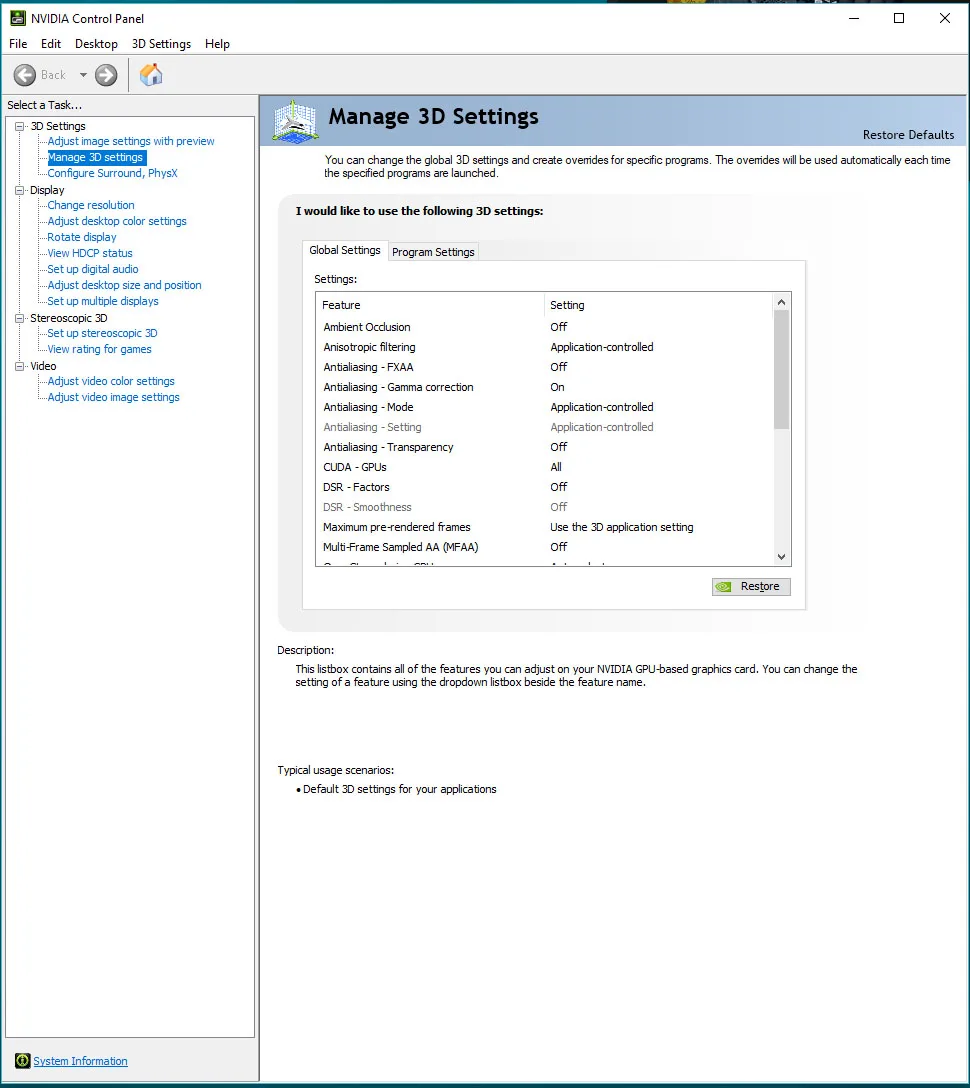
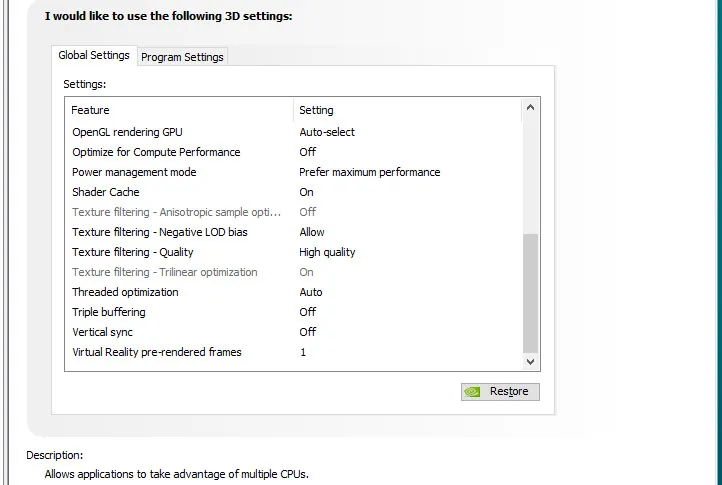 Let’s check out overclocking, temperatures, and noise next.
Let’s check out overclocking, temperatures, and noise next.
Overclocking, temperatures & noise
The Red Dragon RX 5600 XT 6GB is a low-power and quiet card even when overclocked. At stock settings, we could not hear it over the fans of our PC even when it ramps up, unlike with the Red Devil RX 590 or even the RX 570. 
Above default tuning settings used maxed-out Heaven 4.0 running at stock clocks which allowed the Boost clocks to stay right around 1739MHz which is well above AMD’s typical clocks and also 10MHz higher than the ASUS RX 5600 XT EVO OC’s average 1729MHz clock.
The Red Dragon stayed cool generally at or below 75℃ even under a heavy load so its dual fans never became intrusive although it is slightly louder than the ASUS card. The RTX 2060 is another quiet card and it’s hard to pick based on (lack of) noise. At stock fan settings, the Red Dragon RX 5500 XT 8GB runs about 15℃ warmer than the ASUS card’s temperatures but we couldn’t hear either card over our PC’s cooling fans.
Overclocking is locked down to +2% on the core (1787MHz) and a max memory speed of 1860MHz. However, maxing out the overclock uses 25W more power and the temps go up.
If the power limit is set to maximum, performance increases by a small fraction, but the extra power used generates extra heat. For each user, we would recommend finding their GPU’s sweet spot for undervolting with max performance. 
We will check performance compared with two other competing cards using 50 games, and then head for our conclusion.
Performance Summary Charts & Conclusion
Here are the performance results of 50 games and 3 synthetic tests comparing the PowerColor Red Dragon RX 5600 XT 6GB with the ASUS RX 5600 EVO OC 6GB, and versus the RX 2060 Founders Edition 6GB. Although the Red Dragon RX 5500 XT is designed for Ultra 1080P, the benches were also run at 2560×1440 to push the card beyond its limits.
Most gaming results show average framerates in bold text, and higher is better. Minimum framerates are next to the averages in italics and in a slightly smaller font. The games benched with OCAT show average framerates but the .1 minimums are expressed by frametimes in ms where lower numbers are better.
The first column gives the ($299) RTX 2060 FE performance results versus the Red Dragon RX 5600 XT ($289) in the second, and versus the ASUS RX 5600 XT EVO OC ($309) in the last. Performance “wins” are given by yellow text; yellow is also used for ties.
The Red Dragon RX 5600 XT is consistently faster than the more expensive ASUS EVO OC XT, probably due to its higher game/boost clocks. And it also does very well against the more expensive RTX 2060 where they trade blows.
Of course, the bigger picture adds the less expensive GTX 1660 Super and Ti cards into the mix. However, the Ti was almost made instantly irrelevant by the Super card which was not only fractionally slower, but much less expensive
The Big Picture
In this larger view, we add a few more cards – the EVGA GTX 1660 Super XC as well as a Red Devil RX Vega 56. In addition, we benchmark a Red Devil RX 590 and a vanilla EVGA RTX 1660 XC and a EVGA GTX 1060 SC 6GB as well as the lower end Pulse and Red Dragon RX 5500 XTs and the Red Devil RX 570.
We can see that the ASUS RX 5600 XT EVO OC is much faster than either the GTX 1660 Super or the Ti winning most of the benches. Although the GTX 1660 Ti has never justified its $50 more expensive price tag against the Super, the RX 5600 XT gives much more performance for its $289 price tag. The Red Dragon RX 5600 XT trades blows with the RTX 2060. Considering that it is priced $10 cheaper than the RTX 2060 and $20 cheaper than the slower ASUS RTX 5600 XT, we’d say it is a good value.
Let’s check out our conclusion.
Conclusion
The Red Dragon RX 5600 XT 6GB at $289/$299 (PowerColor’s MSRP is $289; we find it for sale at $299) brings an incrementally higher level of performance than the $309 ASUS RX 5600 T EVO OC, and it does very well against the RTX 2060. Any of these three cards would be an excellent upgrade from a RX 560/570 level of card. For playing older games, they are OK for 1440P gaming although they may require lowering settings for some modern titles.
AMD brings some great new features with Adrenalin 2020 software that turns it into an all-in-one platform for launching games, streaming, and sharing. And there is currently a great gaming bundle that really adds to the Red Dragon’s value at Newegg. Bundled RE3, Monster Hunter World, and a 3 month Xbox PC Pass bundle are very tempting free add-ons. The RTX 2060 that are priced at $299 do not come with any game bundles. For some gamers, their choice may come down to deciding if ray tracing effects with an entry level card are worth it now for the few games that implement some of these features coupled with a performance hit.
The PowerColor Red Dragon RX 5600 XT 6GB is a very handsome and solid modern Navi card with improving performance potential for AMD gamers that no longer happens with the older Polaris and Vega cards.
Red Dragon RX 5600 XT 6GB Pros
- The Red Dragon RX 5600 XT 6GB brings great new features at $289 and it’s faster than the more expensive ASUS RX 5600 XT EVO OC
- 14Gbps memory out of the box with no need to update the BIOS
- New RDNA architecture brings higher performance per clock and per watt
- Twenty new or updated features include anti-lag technology and Radeon Boost for competitive gamers and image sharpening for everyone with Adrenalin 2020 drivers
- The Red Dragon RX 5600 XT 6GB is a fast card for ultra 1080P gaming, high 1440P gaming, and a performance and power improvement over the Polaris series
- The Red Dragon RX 5600 XT trades performance blows with the RTX 2060
- Comes bundled with RE3, Monster Hunter World, and with the XBox PC Pass by some resellers
Cons: None
Nitpicks: No hardware ray tracing; overclocking locked down
The Verdict: Good Value
- 7nm hardware and new architecture brings 1080P RX 5600 XT AMD graphic cards to a higher playing field. RDNA will power several more years of Radeon PC graphics
- The RX 5600 XT brings a solid improvement over AMD’s last Polaris generation, and Adrenalin 2020 Edition software brings welcome new and improved features for AMD gamers
Extra new choices arriving with the RX 5600 XT benefit 1080P/1440P gamers looking for an upgrade. PowerColor makes an exceptionally nice offering with the Red Dragon, and together with its bundled games at Newegg for a limited time sweeten the deal.
We are going to take a short break to set up a Z390 motherboard with a clean installation of Win 10 in anticipation of an upcoming T-Force 2x32GB DDR4 memory kit review. Mario will post an Autonomous L-Shaped standing desk review in the meantime.
Happy Gaming!


